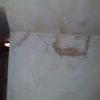- Joined
- 2 Dec 2018
- Messages
- 2
- Reaction score
- 0
- Country

I would really appreciate some advice about a problem with a re-skim.
1930's house, there was a brick wall that had a small chimney (kitchen stove) on the other side of it. When the chimney was taken down I could see all of the tar and creosote
on the bricks. It stunk too. I chipped it all off, even used a grinder to remove every last bit. This side of the wall is plaster boarded and I have no issue with it.
The side that did not have the chimney was due a re-skim, some of the old plaster had come away at the top of the wall (in line with chimney) and I could smell the tar again. Stupidly, I didnt do anything about this, hoping that when it was patched and skimmed it would be fine. It has now been 3 weeks now and this bit of plaster just wont dry out. I had the whole hall stairs and landing done and everywhere else dried within 4 days. This patch is at the top of stairs, and now when we cook, (boil vegetables, rice etc) this patch gets more damp. Then it goes back to being a bit damp and never dries. (due to renovations I have no kitchen door at the moment).
I decided to write this post, because a lot of other posts get confused by damp issues. This wall is an internal wall, and even though I knew it was not leaking, I have been in the loft, checked either side of the top of the wall, and it is bone dry. A lot of very dry dust can be disturbed when lifting insulation, no way there is a leak.
I am pretty sure the plaster has got contaminated, I can also see oily blotches in a few places. What are my options please, If I stop cooking for a few weeks, will it dry for good? Does it need to be hacked off? What do I do to stop a repeat problem.
1930's house, there was a brick wall that had a small chimney (kitchen stove) on the other side of it. When the chimney was taken down I could see all of the tar and creosote
on the bricks. It stunk too. I chipped it all off, even used a grinder to remove every last bit. This side of the wall is plaster boarded and I have no issue with it.
The side that did not have the chimney was due a re-skim, some of the old plaster had come away at the top of the wall (in line with chimney) and I could smell the tar again. Stupidly, I didnt do anything about this, hoping that when it was patched and skimmed it would be fine. It has now been 3 weeks now and this bit of plaster just wont dry out. I had the whole hall stairs and landing done and everywhere else dried within 4 days. This patch is at the top of stairs, and now when we cook, (boil vegetables, rice etc) this patch gets more damp. Then it goes back to being a bit damp and never dries. (due to renovations I have no kitchen door at the moment).
I decided to write this post, because a lot of other posts get confused by damp issues. This wall is an internal wall, and even though I knew it was not leaking, I have been in the loft, checked either side of the top of the wall, and it is bone dry. A lot of very dry dust can be disturbed when lifting insulation, no way there is a leak.
I am pretty sure the plaster has got contaminated, I can also see oily blotches in a few places. What are my options please, If I stop cooking for a few weeks, will it dry for good? Does it need to be hacked off? What do I do to stop a repeat problem.

